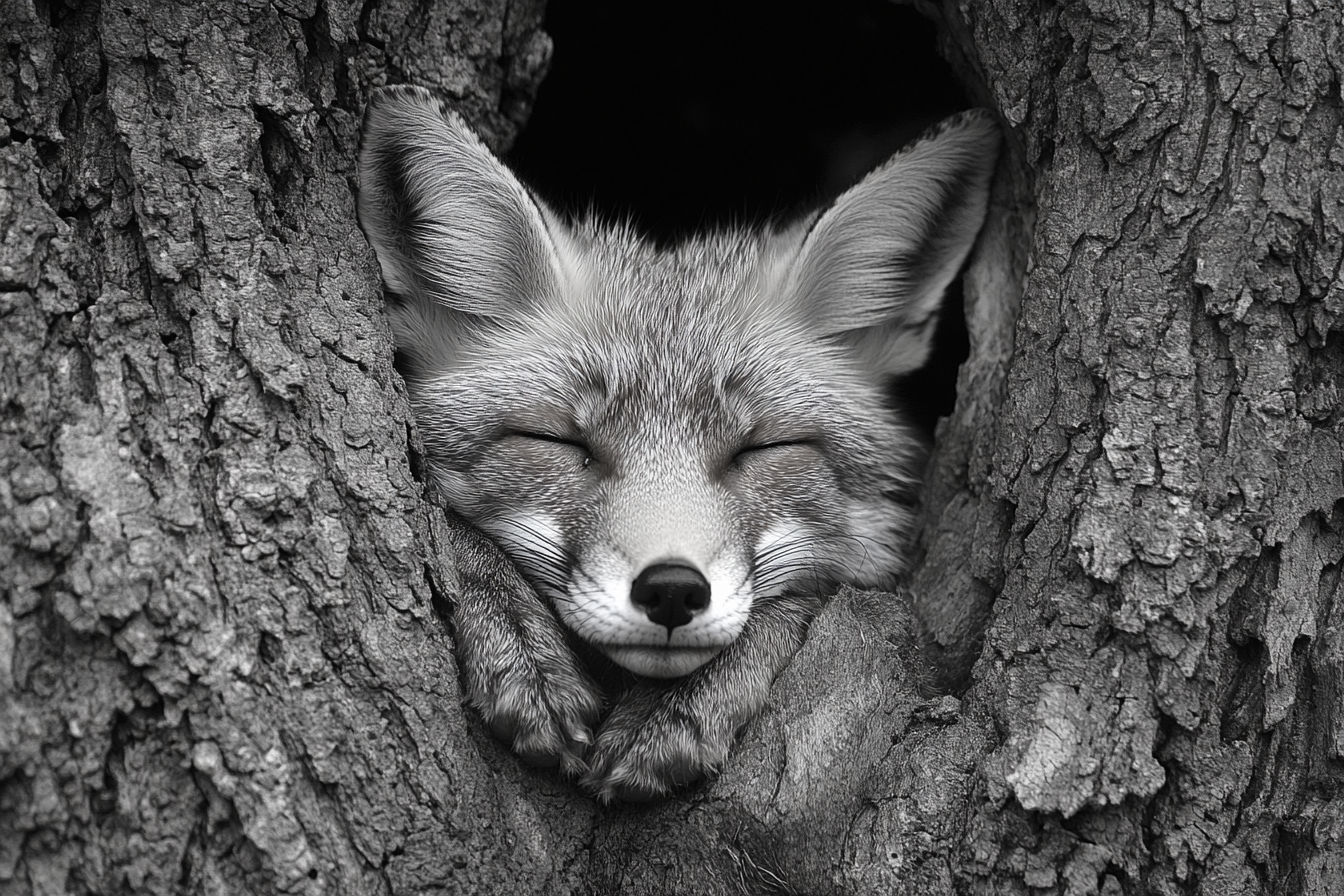Where Do Foxes Go During the Day? Uncovering Their Secret Hideouts
Uncover the secret daytime world of Britain’s foxes. This guide reveals their hidden dens, daily routines, and why you see them when you least expect it.

This post may contain affiliate links. If you make a purchase through these links, we may earn a commission at no additional cost to you.
It’s a familiar sight for many of us across Britain. You’re washing up after dinner or drawing the curtains, and you catch a flash of orange fur slinking across the lawn. A pointy snout, a bushy tail, and then, just as quickly, it’s gone. The red fox is our most common and cunning wild neighbour, a master of blending into the background of our lives. We mostly see them at dawn or dusk, these shadowy figures of the twilight hours.
But this raises a fascinating question. If they’re so busy at night, where on earth do they go during the day?
Do they simply vanish into thin air? Do they have secret underground cities? The truth is a little less magical but no less interesting. Foxes lead a complex double life, and their daytime habits are the key to understanding how they’ve so successfully conquered both the British countryside and our bustling towns. This guide will pull back the curtain on their secret world, revealing everything from their hidden homes to their daily routines.
Are Foxes Truly Creatures of the Night?
First things first, let’s tackle a common idea. We think of foxes as being nocturnal, meaning they’re active at night. And for the most part, that’s true. Their eyes are perfectly adapted for low light, and the cover of darkness helps them hunt and avoid their main threat: humans. They are most active at dusk and dawn, a behaviour known as being crepuscular. This is when their prey—small mammals like mice and voles—are also out and about.
However, if you live in a British town or city, you’ve probably seen a fox trotting brazenly down the pavement in the middle of the afternoon. So, what’s going on?
The simple answer is that foxes are brilliant opportunists. They’ve learned that in urban areas, people aren’t much of a danger. Cars are a problem, but the grumpy man from number 42 shaking his fist is not. This confidence means they’ll happily break their nocturnal routine for a good reason.
Reasons you might see a fox during the day include:
- Looking for food: If a fox is hungry or has cubs to feed, it will search for food whenever it can. An overflowing bin or a tasty takeaway dropped on the pavement is too good to miss, no matter the time.
- Peace and quiet: In a busy park or on a school playing field, midday might actually be the quietest time for a fox to travel undisturbed.
- Youngsters exploring: Young, bold foxes are often less cautious and more curious than their parents.
- Sunbathing: Just like us, foxes enjoy a bit of sun. On a quiet, sunny day, you might spot one having a snooze in a secluded spot.
It’s a common myth that a fox seen in daylight must be sick with mange or rabies (rabies, by the way, has been absent from the UK for decades). While a very sick fox might act strangely, a healthy-looking fox trotting about its business in the daytime is usually just a sign of a confident, well-adapted animal.
The Fox’s Den: A Home, a Nursery, and a Fortress
So, when they’re not out and about, where do foxes rest their heads? A fox’s home is called a den or an earth. But it’s not always the deep, underground burrow we might imagine. They actually have a few different types of hideouts, ranging from a permanent family home to a temporary spot for a quick nap.
The ‘Earth’: A Subterranean Sanctuary
The main, most important hideout is the earth. This is an underground burrow system that serves as a safe place to sleep, hide from danger, and, crucially, raise a family.
Foxes are surprisingly good diggers, but they’re also lazy. Why dig a new house when you can move into one someone else has already built? They will often take over and expand the abandoned burrows of other animals, like rabbits or badgers. A badger’s home is called a sett, and a fox moving into an unused part of one is like getting a spacious, ready-made flat.
A typical fox earth will have:
- A main entrance: Often under the roots of a tree, in a dense thicket of bushes, or on a sloping bank.
- Multiple escape routes: A smart fox always has a plan B. Their earth will have several smaller, hidden exits, known as bolt holes, so they can make a quick getaway if danger appears.
- Tunnels and chambers: The earth isn’t just one long tunnel. It’s a network that can lead to a main resting chamber and a separate nesting chamber where the vixen gives birth to her cubs.
These earths are used year after year, sometimes by generations of the same fox family. They are most important during the cubbing season in spring.
Above-Ground Lairs: A Place for a Daytime Nap
Digging and maintaining an earth is hard work. For a quick nap or a place to rest during the day, a fox will often use a simpler, above-ground hideout. These spots are sometimes called ‘couches’ or ‘kennels’.
These are sheltered resting places where the fox can stay hidden but still be aware of its surroundings. Think of it as the fox equivalent of dozing on the sofa instead of going to bed.
Excellent spots for a fox couch include:
- In a dense patch of brambles or nettles.
- Under a thick, low-growing bush.
- In a pile of logs or garden rubbish.
- At the base of a large tree.
- In long grass or bracken.
The key is shelter and concealment. These spots allow the fox to stay out of sight and protected from the worst of the British weather, while being able to bolt in an instant if needed.
Urban Foxes vs. Country Foxes: A Tale of Two Hideouts
A fox’s choice of home depends entirely on its surroundings. Britain offers two very different worlds for a fox: the traditional countryside and the modern, man-made jungle of our towns and cities.
In the Concrete Jungle: The Urban Fox’s Address Book
Urban foxes have become masters of using our world to their advantage. Their daytime hideouts are a perfect example of this. Instead of hedgerows and badger setts, they use the structures we build.
The number one prime real estate for an urban fox is underneath a garden shed. It’s dark, dry, and already has a solid roof. The space beneath wooden decking is another favourite. It provides the same security and is often left completely undisturbed.
Other popular urban fox hideouts include:
- In overgrown gardens: That forgotten corner at the back of the garden, full of weeds and old junk, is a five-star fox hotel.
- Railway embankments: These are fantastic wildlife corridors through our cities. They are steep, covered in dense bushes, and humans rarely go there.
- Cemeteries and allotments: These spaces are quiet, especially during the day, and offer plenty of cover.
- Under garages or in empty buildings: Any structure that offers a dark, quiet space is a potential den.
Urban foxes have smaller territories than their country cousins because food is so readily available (thank you, leaky bin bags and leftover pizza). This means their dens are often much closer to our homes, which is why we’re so much more likely to stumble across them.
In the Rolling Hills: The Rural Fox’s Estate
In the countryside, foxes have more space and more natural options for their homes. Their territories are much larger, as they have to work harder to find food.
Rural fox earths are commonly found:
- In woodland: Especially on the edges, where they can easily hunt in the neighbouring fields.
- In hedgerows: The dense roots and banks of old hedgerows provide a perfect, stable place to dig.
- On steep banks or in quarries: These locations are difficult for predators (or angry farmers) to access and provide a commanding view of the surroundings.
- In rocky outcrops: Natural crevices and small caves make excellent, ready-to-use dens.
As mentioned, they are also happy to share larger burrow systems with other animals, particularly badgers. While they’re not exactly friends, they can live as neighbours, using different entrances and chambers in a large sett, a bit like people living in the same block of flats.
A Fox’s Daily Timetable: More Than Just Sleeping
So what does a fox actually do all day in its hideout? It’s not just 12 hours of solid sleep. A fox’s day is a mix of rest, grooming, and staying alert.
A typical 24-hour cycle looks something like this:
- Dawn: The fox returns from its night of hunting. Before entering the den, it might spend some time grooming its fur and tidying up.
- Morning: This is a time for deep sleep, usually underground in the earth to stay hidden and safe.
- Midday: The fox might move from the earth to an above-ground couch to catch some sun. It will be dozing rather than in a deep sleep, and its ears will be twitching, listening for any sign of danger.
- Afternoon: More light sleeping and resting. If it has cubs, this is when they might start to get restless and play near the den entrance, waiting for their parents to wake up.
- Dusk: The fox becomes fully active. It will stretch, yawn, and socialise with its family before heading out for the nightly patrol and hunt.
This routine changes dramatically depending on the time of year.
- Winter (December-January): This is mating season. Foxes are much more vocal (the source of those blood-curdling screams you hear at night!) and travel further, so they might be seen more during the day.
- Spring (February-April): This is cubbing season. The vixen (female fox) gives birth in the main earth and will barely leave her cubs for the first few weeks. The dog fox (male) is responsible for bringing her food. This is the most critical time for a fox den to be left undisturbed.
- Summer (May-August): The cubs are now bigger and need a lot of food. Both parents will be hunting flat out. The cubs will spend their days playing near the den, learning skills from their parents. This is the best time to see a fox family.
- Autumn (September-November): The cubs are now almost fully grown and are starting to leave the family to find their own territories. The main earth is used less as the family unit breaks up.
How to Spot a Fox Den (Without Disturbing Them)
If you’re a wildlife enthusiast, you might be curious to see if you have a fox den near you. It’s possible to identify one, but it’s vital that you do so from a distance and never, ever disturb it. Foxes are protected by law, and disturbing a den with cubs inside is cruel and illegal.
Here are the key signs to look for:
- The Entrance: A fox earth entrance is typically a D-shape on its side and about 20cm (8 inches) wide. It will look well-used, not covered in cobwebs or leaves. There might be freshly dug soil fanned out from the entrance.
- The Smell: Active fox dens have a very distinct, musky odour. It’s not unpleasant to everyone, but it’s certainly strong and recognisable.
- Food Scraps: Unlike badgers, who are very clean, foxes can be messy. You might find discarded food remains near the entrance, such as feathers, rabbit fur, or small bones.
- Droppings (Scat): Foxes use their droppings to mark their territory. You’ll often find scat on prominent places near the den, like on a log or a tuft of grass. They are typically long, twisted, and pointy at one end.
- Flies: In summer, a large number of flies buzzing around a hole in the ground is a strong indicator that there are cubs and food scraps inside.
- Well-Worn Paths: Look for clear tracks in the grass or undergrowth leading to and from the hole.
Remember: look, but don’t touch. Use binoculars to get a better view and enjoy watching these amazing animals from a safe and respectful distance.
A Fox in the Garden: What Should You Do?
Discovering you’re sharing your garden with a family of foxes can be a magical experience. But for some people, it can also be a worry. What if they dig up the prize-winning roses or leave a mess?
First, don’t panic. The best approach is usually to live and let live. A fox family will only be highly active around the den for a few short months in the summer. Watching the cubs play and grow is a rare privilege. They pose no danger to you or your pets (a cat is more than a match for a fox, and dogs are seen as predators).
If you are determined that you don’t want them there, you must use humane methods.
- Never block a hole! This is the most important rule. You could trap foxes or cubs inside, leaving them to starve. This is incredibly cruel and is illegal under the Wild Mammals (Protection) Act 1996.
- Use gentle deterrents: Foxes don’t like strong human smells. Leaving smelly rags soaked in things like citronella oil near the den (but not in it) can encourage them to move on once the cubs are old enough. Commercially available, non-toxic animal repellents can also work.
- Wait until autumn: Once the cubs have left the den in the autumn, you can then safely block the entrance to prevent them from using it again next year.
If you’re concerned about a sick or injured fox, or need advice on a den, contact a professional organisation. The RSPCA or a local wildlife rescue like The Fox Project can provide expert help.
Conclusion: The Secret Life of Our Most Adaptable Neighbour
So, where do foxes go during the day? They go home.
Whether that home is a sprawling underground earth in an ancient woodland or a snug hollow under your garden shed, it’s their sanctuary. It’s where they rest, raise their young, and shelter from the dangers of the world.
The red fox is not a phantom that melts away with the morning sun. It is a creature of immense adaptability, one that has woven its life around ours. By understanding their daytime habits, we can better appreciate the secret, complex world of our most fascinating and successful wild neighbour. The next time you see that flash of orange, you’ll know that it’s not disappearing—it’s just heading home for a well-earned rest.
Further Reading
For those interested in learning more about foxes and how to coexist with them, these resources are highly recommended:
- The Wildlife Trusts: An excellent source of information on all British wildlife, including foxes.
- The Mammal Society: A charity dedicated to the study and conservation of British mammals.
- The RSPCA: Provides advice on dealing with sick or injured wildlife and humane deterrence.
- The Fox Project: A charity dedicated specifically to the red fox, offering rescue services and advice.






